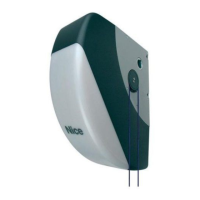ENGLISH – 5
INSTALLATION
3
3 INSTALLATION
3.1 PRE-INSTALLATION CHECKS
a
The installation must be carried out by qualied
personnel in compliance with the current legisla-
tion, standards and regulations, and with the in-
structions provided in this manual.
Before proceeding with the product’s installation, it is necessary to:
– check the integrity of the supply
– check that all the materials are in good working order and suited
to the intended use
– make sure that the structure of the door is suitable for being
automated
– make sure that the characteristics of the door fall within the op-
erating limits specied in the “Product usage limits” paragraph
– verify that there are no points of greater friction during the open-
ing and closing movements along the entire door path
– verify that the area where the gearmotor is installed allows for
unlocking the latter and manoeuvring easily and safely
– verify that the mounting positions of the various devices are pro-
tected against impacts and that the mounting surfaces are suf-
ciently sturdy
– prevent any parts of the automation from being immersed in wa-
ter or other liquids
– keep the product away from heat sources and open ames and
acid, saline or potentially explosive atmospheres; these may
damage the product and cause malfunctions or dangerous sit-
uations
– connect the control unit to an electricity supply line equipped
with a safety earthing system
– include a device on the electric power line ensuring complete
disconnection of the automation from the grid. The disconnec-
tion device must have contacts with a sufcient gap to ensure
complete disconnection, under the Category III overvoltage con-
ditions, in accordance with the installation instructions. Should it
be necessary, this device guarantees fast and safe disconnection
from the power supply; it must therefore be positioned in view of
the automation. If placed in a non-visible location, it must have a
system that blocks any accidental on unauthorised reconnection
of the power supply, in order to prevent dangerous situations.
The disconnection device is not supplied with the product.
3.2 PRODUCT USAGE LIMITS
The data relative to the product’s performances is included in the
“TECHNICAL SPECIFICATIONS” chapter and is the only data
that allows for properly assessing whether the product is suitable
for its intended use.
Check the application limits of SO2000 and of the accessories to
be installed, assessing whether their characteristics are capable of
meeting the requirements of the environment and the limitations
specied below:
– the door dimensions must be below 215ft2 40in2 1/16 (20mq)
– the drive shaft must be compatible with the SO2000 output and
the relative keys supplied with the package
– the wall-mounting bracket must be sufciently long.
Table 1
SO2000 - LIMITATIONS OF USE IN RELATION TO THE TYPE OF
DOOR
Type of door Operating limits (m)
Door
Max height 16ft 4in
55/64 (5m)
Max width 13ft 1in
31/64 (5m)
The measurements shown in “Table 1” are purely indicative and
are only needed for making a rough estimate. The actual suitability
of SO2000 for automating a specic door depends on the degree
of leaf balancing, guide friction and other aspects, including occa-
sional events such as wind pressure or the presence of frost, which
could obstruct the leaf’s movement.
To determine the actual conditions, the force required to move the
leaf throughout its path must be measured, to ensure that this value
does not exceed the “rated torque” specied in the “TECHNICAL
SPECIFICATIONS” chapter; moreover, to calculate the number of
cycles/hour and consecutive cycles, it is important to consider the
data shown in “Table 2”.
Table 2
SO2000 - LIMITS RELATING TO THE FORCE REQUIRED TO MOVE
THE DOOR LEAF
Force required to move the
leaf (N)
Maximum no. of cycles/hour
Maximum no. of consecutive cycles
Up to 120
20
35
120 ÷ 180
18
33
180 ÷ 220
15
30
a
The control unit is equipped with a manoeuvre lim-
iting device that prevents possible overheating; it is
based on the motor load and duration of the cycles,
and intervenes when the maximum limit is exceed-
ed.
3.2.1 Product durability
The product’s durability is its average economic life value and is
strongly inuenced by the degree of severity of the manoeuvres: in
other words, the sum of all factors that contribute to product wear.
To estimate the durability of your automated device, proceed as
follows:
1. add the values of the items in “Table 3” relative to the sys-
tem’s conditions
2. in the graph shown in “Figure 2”, from the value obtained
above, trace a vertical line until it intersects the curve; from
this point trace a horizontal line until it intersects the line of
the “manoeuvre cycles”. The value obtained is the estimated
lifetime of your product.
The durability values shown in the graph can only be obtained if the
maintenance schedule is strictly observed – see the “PRODUCT
MAINTENANCE” chapter. The durability is estimated on the basis
of the design calculations and the results of tests effected on pro-
totypes. Being an estimate, therefore, it offers no explicit guarantee
of the product’s actual useful life.
Example of durability calculation: automation of a door
weighing 286lb 9oz (130 Kg)
“Table 3” shows the “severity indices” for this type of installation:
30% (“Weight of the door”), 20% (“Force required to move the
door”) and 10% (“Ambient temperature above 40°C or below 0°C
or humidity above 80%”).
These indicators must be added together to obtain the overall se-
verity index, which in this case is 60%. With the value identied
(60%), look at the horizontal axis of the graph (“severity index”) and
identify the value corresponding to the number of “manoeuvre cy-
cles” that the product can perform throughout its lifetime – roughly
18,000 cycles.

